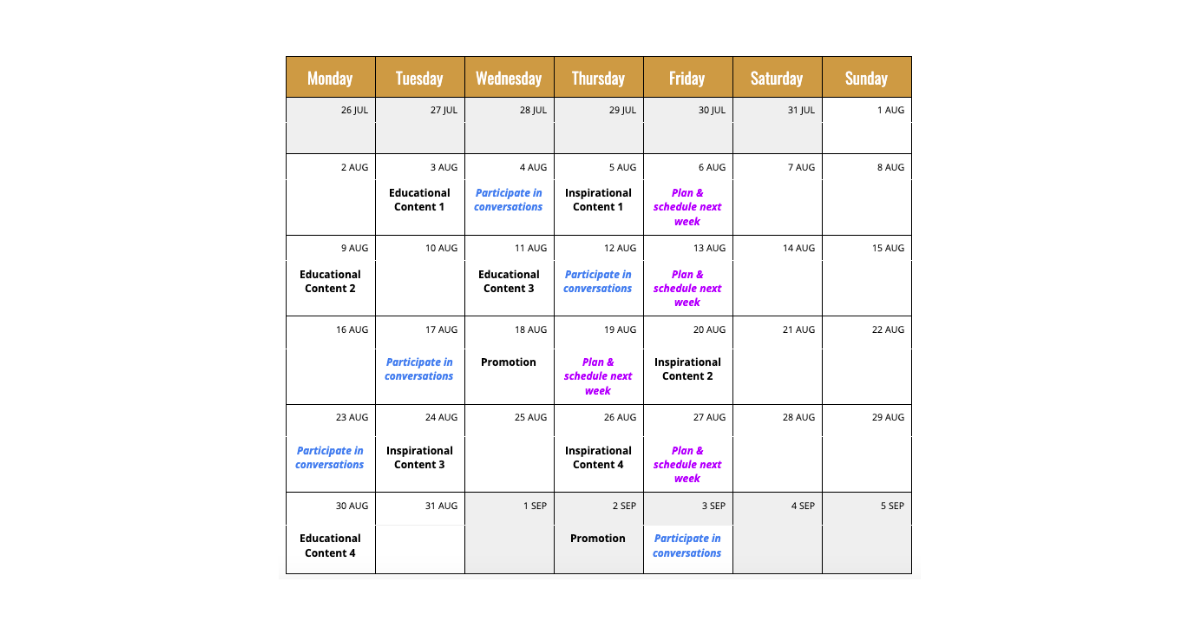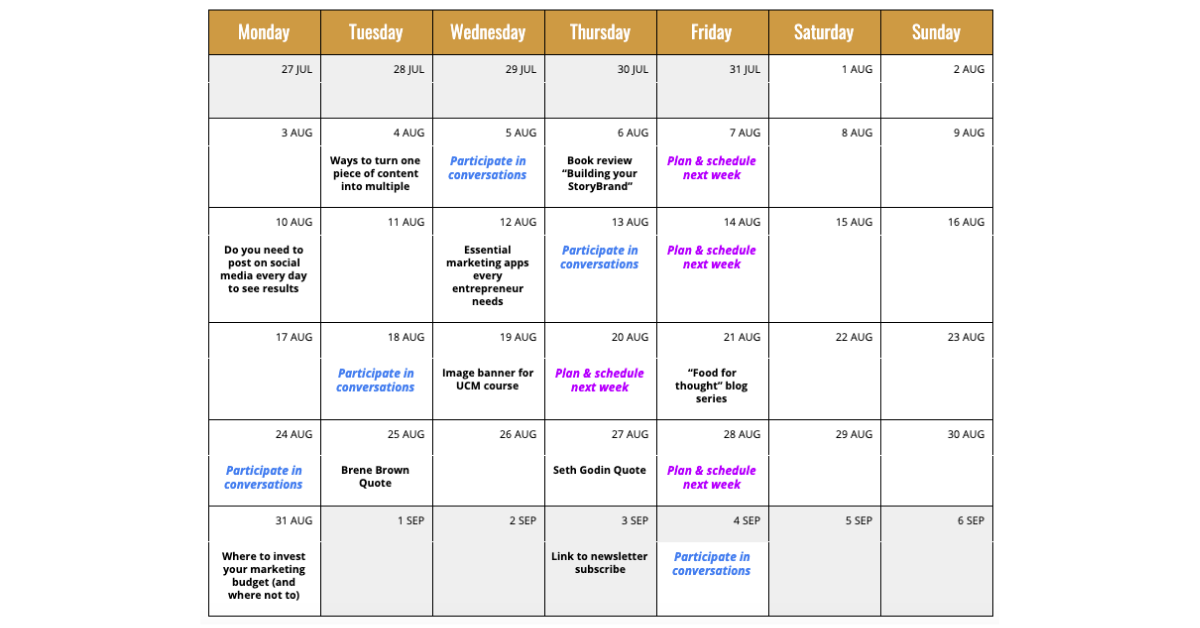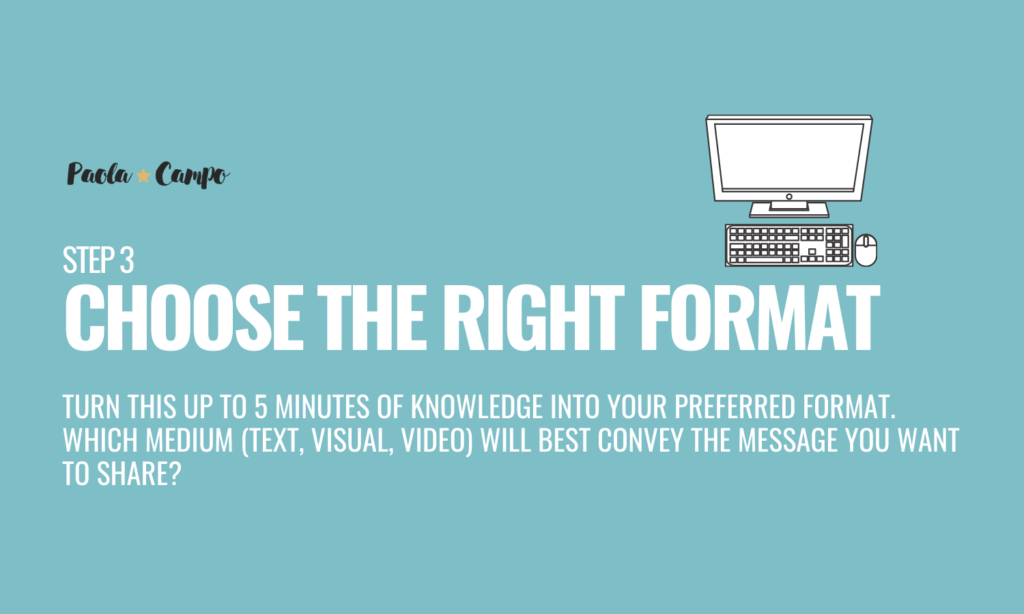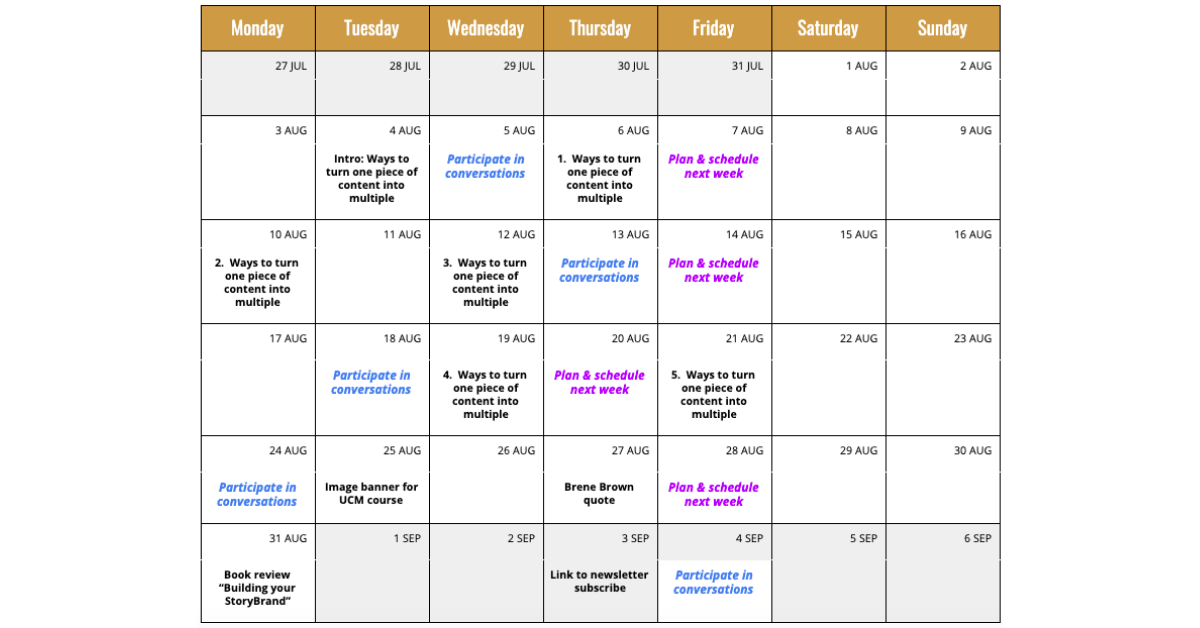Section 3. Implementing your content strategy
How do you turn potential clients into closed deals? You create content that moves them along every stage of their buyer journey. But first, you have to get their attention and establish yourself as a reliable partner. Now is the time to kick things off!

Let’s imagine for a moment you’re going to throw a party.
What are the components of a successful party? You need to have a nice location for the type of party you’re hosting. You need a certain ambiance, with decoration and music. You need to have refreshments or an actual meal. And finally, the one thing that makes a party a, well, party, you need people— and not just anyone, but the right guests you get to enjoy your party with the most.
There are other important considerations for throwing a party, but for the purposes of the analogy you know it’s coming, let’s leave it at those items.
When you think about your content marketing strategy as a party:
- The location of your party corresponds to your digital spaces. Think about social media, email lists, your website.
- The ambiance you create with your decoration and music is your brand or business identity. Think about the colors you use in your visual elements, your logo, images, sounds.
- The refreshments, whether they are finger foods, cocktails, or a full meal, that’s your content. Depending on the type of party, even the music can be content.
All the steps you’ve been learning so far are helping you organize that amazing party that is your content strategy. Once the venue is ready, the band is all set up, and the food prepared, it’s time to have a blast, right?
Well, you’ve probably noticed by now we’re missing a pretty important component: your guests.
A crucial element of your content strategy is how you socialize it, especially when you’re getting started promoting your business through content.
Consistently creating content will increase your visibility and generate interest in your business, but it takes time to build that interest. A strategic networking effort will give your content strategy a little boost.
In this section, we’re going to focus on the three essential aspects of a successful content strategy implementation:
- How to run an organized, seamless content strategy every month
- How to bring more eyes into the content you create
- How to turn every piece of content you have into even more content
To start, we’re going to be creating your content calendar, the cornerstone of that content strategy you’ll be running on a regular basis.
One of the top questions I get from clients is the frequency of content publishing. There’s no right or wrong answer here. For example, some people post content on social media every day but only publish on their blog once a month.
Does that mean you have to start publishing content every single day? The key to your publishing schedule is to do what feels right and do it consistently. If you’re only starting your foray into content marketing, I don’t recommend daily posting. It’s better to start low and increase your frequency as you get more comfortable with content.
My advice is to start publishing and sharing content on publicly available platforms (your website or social media channels) twice a week. It’s challenging enough to stretch your content creating muscles, but not too much that it will feel like you’re spending all your time doing that. And remember, your content strategy will not only involve publishing content. You’ll have to allocate time to create the content and network, too.
Your publishing calendar should look like this:
This calendar has different posting days per week, and it allocates time for content creation, planning, and networking.
- Plan and schedule next week: pretty self-explanatory. It’s always good to allocate the time to plan what you’ll be doing the next week. This is also the time you can use to create content.
- Posting days: these are the days where your content goes out into the world, more specifically, on public social media channels. As you can see, the majority of this content is from the knowledge/education and inspiration/aspiration categories.
- Participate in conversations: networking will be a big part of your content strategy, only this type of networking will happen online. Participating in conversations will give a great boost to your online business profile and elevate the visibility of your content.
You’ve probably noticed I have deliberately excluded these activities during weekends. I’ve done this for two reasons:
- Regardless of the platform, most social media posting activity tends to concentrate between Monday and Friday. The case is even stronger for those of you who offer B2B or professional services.
- You also need a break and the opportunity to enjoy other activities that can potentially inspire you to create more content.
When does weekend posting make sense? That depends mainly on the nature of your product or service. For example, consumer goods get many posts during weekends, and so do the live-sharing type of posts (e.g., from a specific event you’re attending).
Now it’s your turn. Grab the topics you identified in the previous section and allocate them in one month following the calendar blueprint. As an example, let’s take a look at how I distributed my topics.
At this point, you may be wondering, wow, that looks like a lot of content to create, and you’d be absolutely right. That calendar of topics feels like a full-time job which is the last thing you want to feel when implementing your content strategy.
When you look at your topics closely, you probably realize that some of those can be pretty substantial, comprehensive pieces of content. Some of them may feel like they could become books.
I bet you know where this is going.
This technique I’m going to show you will add a couple of months’ worth of content without having to brainstorm a single piece of new content to the mix! I documented the entire process in this blog post, so go check it out in detail. Here are the highlights:
Step 1 - Choose your topic

You begin by choosing one of those topics at the top of the least that feels like it has a lot of content to cover. In my example, the topic you see as “Ways to turn one piece of content into multiple,” I created following this approach.
Step 1 - Break it down into small pieces
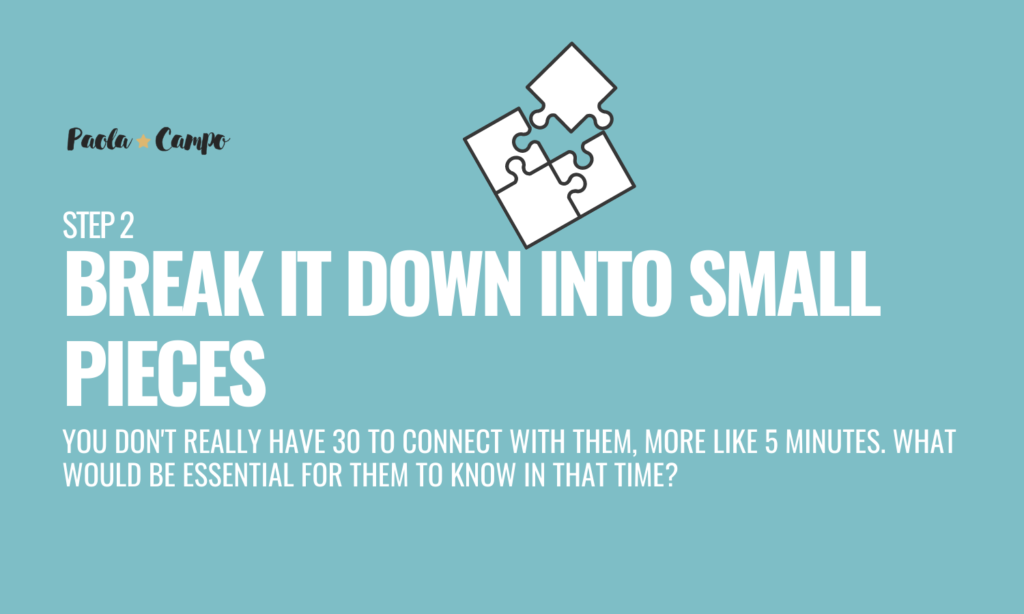
I made this topic into a five-step process: 1. Choose your topic, 2. Break it down into small pieces, 3. Choose the right format, 4. Share your pieces every day, 5. Consolidate into a bigger asset. I know; it’s probably a bit meta that my example is the actual process you’re learning right now.
Step 3 - Choose the right format
Step 4 - Share your pieces every day
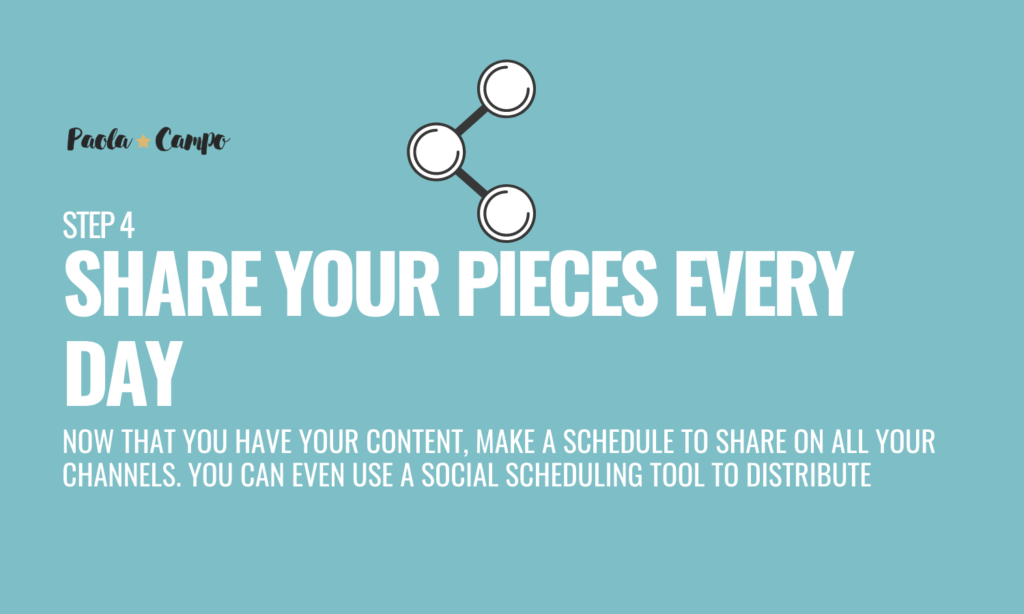
This means, for my publishing schedule, I have five days worth of content. Before publishing this video series, I even made a small introduction slider to tease people about this upcoming content. You can check it out here. That’s now six days’ worth of content.
Step 5 - Consolidate into a bigger asset
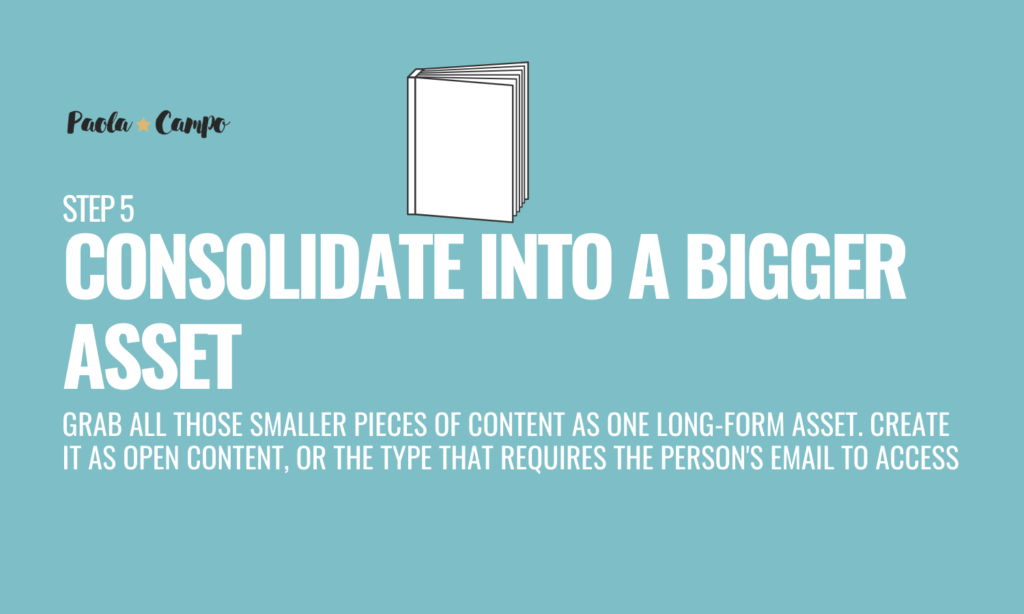
For this particular example, I transcribed the content of all videos and wrote the blog post I referred to earlier. With larger topics, you can turn your content into an eBook and ask people’s email to download it.
Considering this new development, my topic, “Ways to turn one piece of content into multiple,” has now become six separate assets to use in my publishing schedule. That means my calendar now looks like this:
I still have four topics up my sleeve that I can use in the following months of my content strategy calendar. A couple of these can be expanded and broken down into smaller pieces of content (marked with an asterisk below):
- Do you need to post on social media every day to see results
- Essential marketing apps every entrepreneur needs
- “Food for thought” blog series*
- Where to invest your marketing budget (and where not to)*
Now it’s your turn. Go back to your content topic list, highlight the topics you can turn into multiple posts, incorporate some seasonal posts where applicable, and adapt your calendar accordingly. You can even decide to plan several months’ worth of content already.
Section 1: Setting Up Your Content Strategy Basics
A successful content strategy will need a solid foundation to help your business grow.
In this section, you’ll learn how knowing your customers, and the value you deliver to them will shape your path to achievement.
Section 3: Implementing Your Content Strategy
Turning potential clients into closed deals needs content that moves them along every stage of their buyer journey.
In this section you’ll start to get their attention and establish yourself as a reliable partner.
Section 2: Planning And Building Your Content Strategy
Creating content that grabs the attention of your potential client begins with an idea.
In this section, you’ll be turning ideas into a concrete action plan that will set the wheels in motion to establish yourself as a reliable partner.
Free Courses
Duis egestas aliquet aliquet. Maecenas erat eros, fringilla et leo eget, viverra pretium nulla. Quisque sed augue tincidunt, posuere dui tempor.

